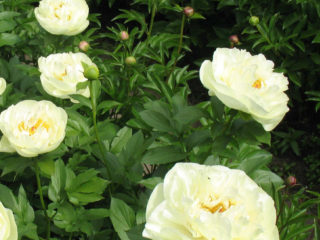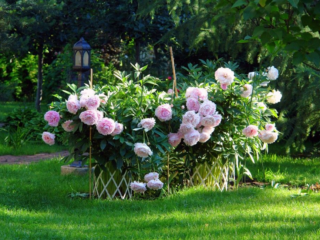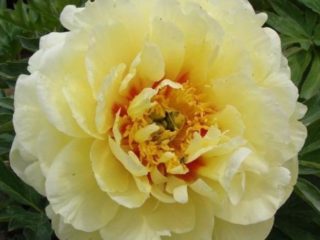Content
The choice of ornamental plants for decorating flower beds and areas can be difficult for both beginners and experienced florists. Peony Lorelei is an excellent solution to this problem. This flower will delight you with its ease of care and unique decorative properties.
Description of the Lorelei peony variety
The plant was bred by breeding in 1996. Lorelei is a hybrid of Lactiflora and Good Chir.
The flower belongs to the semi-dwarf group. The maximum height of "Lorelei" is 70 cm. The bush has several strong stems. The peony garter is required only during the flowering period to give a neat look. One shoot grows 1, rarely 2-4 inflorescences. The stems have numerous erect, sharp leaves.
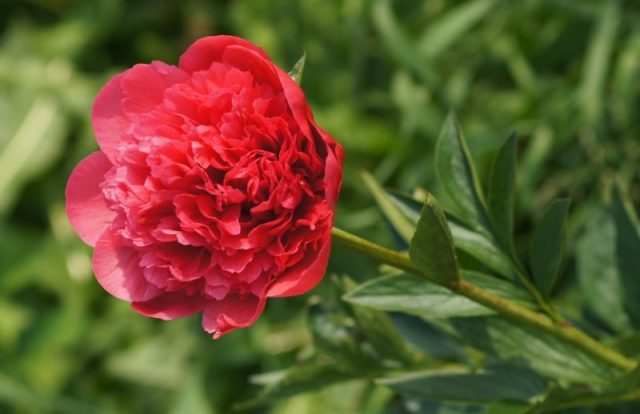
Flowers fade in the sun and become a peach shade
The peony grows well in the shade. It is not recommended to plant "Lorelei" in areas constantly illuminated by the sun. Otherwise, the flowers will lose their brightness and fade. The petals will quickly fade in the sun, losing their characteristic shade.
Breeding peonies are resistant to frost and other unfavorable factors. Therefore, with proper care, "Lorelei" can be grown in regions with any climatic conditions.
Flowering features
"Lorelei" belongs to the group of terry peonies. This is due to the structure of the flower and the large number of petals of different shapes and sizes. The first buds appear in early May, in warm weather - in late April. Peony bloom usually begins in the first half of June and lasts 10-14 days, less often up to 3 weeks.
The buds open slowly. During this period, they are folded and twisted in the form of waves. Because of this, the bud resembles a rose. In the future, the peony blooms, flowers appear on it, 14-16 cm in diameter.
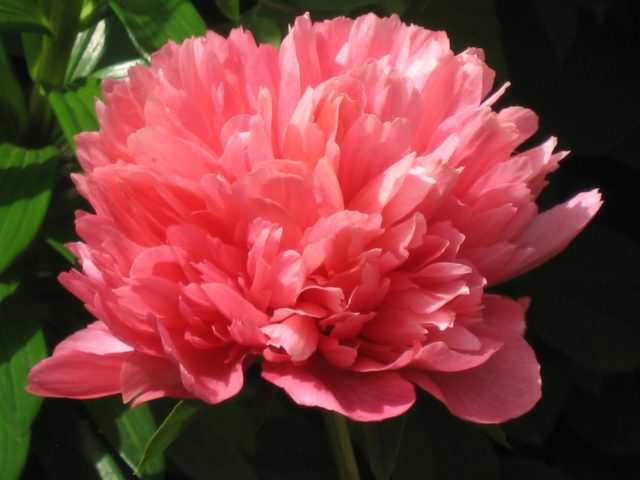
Peony hardly exudes aroma
As you can see in the photo of the Lorelei peony, when opened, the petals have a rich pink-orange, salmon color. In the future, they acquire a more pronounced orange tint. This occurs at the final stage of flowering.
The peony emits a light aroma. You can only feel it if you bring the plant close to your face.
Application in design
Lorelei peonies bloom profusely. A large number of buds appear on one bush. Therefore, such a plant is often used as an independent decorative element. Care should be taken when growing Lorelei next to other flowers.
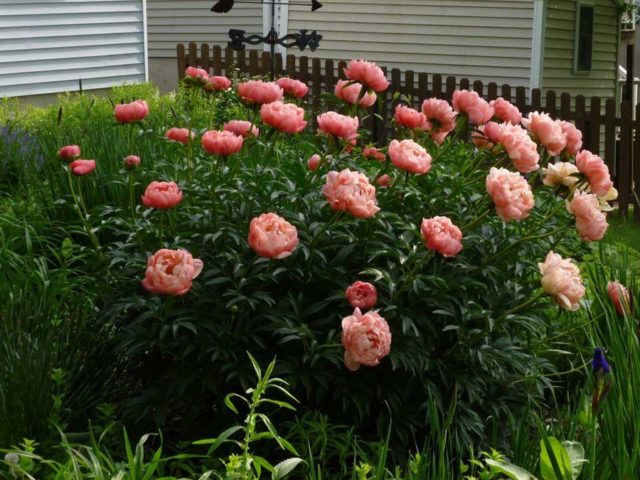
The plant needs several years to take root in a new place.
In flower beds, Lorelei peonies are often used as a background for other ornamental plants. They make any flower arrangement lush and rich.
Peonies pair best with:
- roses;
- asters;
- tulips;
- lilies;
- godets;
- zinnias;
- daylily;
- chrysanthemums.
It is not recommended to grow "Lorelei" in the same flowerbed with lumbago, adonis, anemone and hellebore. These plants quickly deplete the soil, limiting the access to the peonies of nutrients.
Reproduction methods
The Lorelei peony variety is rare. Saplings and seeds of such a plant are expensive and not available in every store. Therefore, for many gardeners, the question of how to reproduce this peony is relevant.
This procedure is carried out by grafting or planting seeds.But the main and most effective method is the division of the rhizome. Renewal buds are formed on the underground shoots of Lorelei. New stems grow from them. In addition, the rhizome of the peony has powerful appendages in which useful substances accumulate. A properly performed division procedure does not harm the plant, but in some cases, on the contrary, is extremely beneficial.
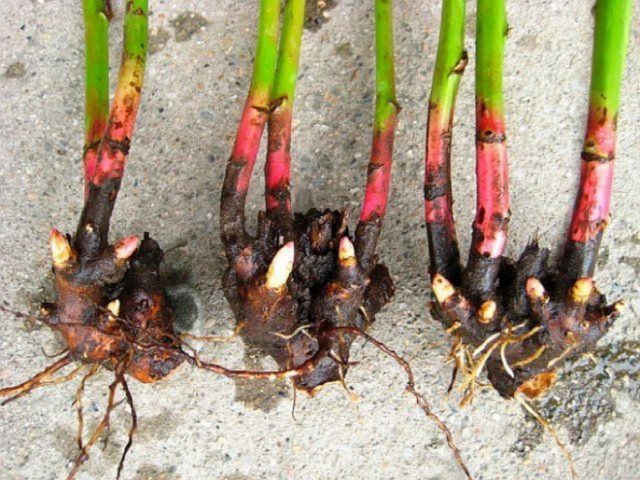
Always leave free space between the seedlings for air circulation.
Division Algorithm:
- Choose a healthy bush "Lorelei" at least 3 years old.
- Cut off the stems.
- Remove soil around the flower.
- Remove the root part, being careful not to harm the appendages.
- Remove soil from the roots, rinse them with water.
- Dry underground shoots for several hours in a dark place.
- Trim the appendages, leaving 10-12 cm each.
- Divide the roots with a pruner, while taking into account the presence of buds.
- Rotten areas, if any, should be cut off, and the places of removal should be treated with crushed coal.
Separated shoots should be planted no later than September 15th. Otherwise, the likelihood increases that the plant will not have time to adapt to the new soil and will die.
Landing rules
Selectively bred peonies grow well in different soil types. The main requirement is the availability of a sufficient amount of nutrients.
For planting, it is recommended to choose shaded areas. A place for peonies must be prepared in advance. 3-4 weeks before planting, a shallow hole 60-70 cm wide is dug. It is filled 2/3 with peat with humus, garden soil and river sand. The components are mixed in equal proportions. In addition, 0.5 liters of birch ash and 200 ml of superphosphate are introduced into the soil.
Before planting, the root appendages of the seedling must be dipped in a heteroauxin solution. 2 tablets and 50 g of copper sulfate are added to 10 liters of water. After dipping, the roots must be dried.
Planting method:
- Break prepared holes.
- Place a drainage layer inside (if necessary).
- Lower the seedling into the hole, sprinkle with a loose mixture of peat and humus.
- Root buds should be 3-5 cm above the ground.
- Sprinkle the top layer of soil with fresh garden soil.
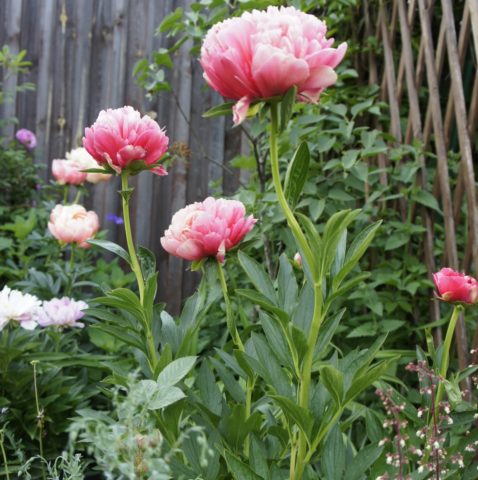
Flowers do not respond well to transplanting, so there is no need to transplant them unnecessarily.
Transplanting bushes to a new place is carried out in a similar way. This procedure is required every 5-10 years, depending on the condition of the plant and the composition of the soil.
Follow-up care
When planting in autumn, the plant should have time to take root before the onset of frost. Otherwise, Lorelei may die. With proper care, this risk is excluded.
After planting and before the onset of frost, watering is carried out 2-3 times. The peony does not need additional liquid. After each watering, it is recommended to loosen the soil around the seedling. This will provide oxygen access to the root system and create conditions for the normal development of the bush.
Mature plants need abundant watering. For each bush, 15-20 liters of water are used. This need is explained by the fact that peony roots grow deep into the soil and may experience a lack of liquid, as it is quickly absorbed on the surface. In late spring and summer, in the absence of rain, watering is carried out every 8-10 days. 6
Peonies are not fertilized more often than once a year.
In April, each bush should be treated with Fitosporin solution. This remedy protects the flower from fungi and bacterial infections.
In August, adult peonies "Lorelei" are fertilized with complex compounds. Phosphorus-potassium solutions are best suited, as they have a positive effect on the number of buds and the quality of flowering.
Every month, you should loosen the soil around the bush. This will prevent liquid stagnation on the surface, which is especially important in rainy weather.
Preparing for winter
At the end of summer, the leaves and stems of Lorelei peonies begin to turn yellow. During this period, you need to gradually reduce the frequency of watering. Before the onset of frost, leaves and stems are removed from the peony. This must be done with a pruner or a sharp knife.
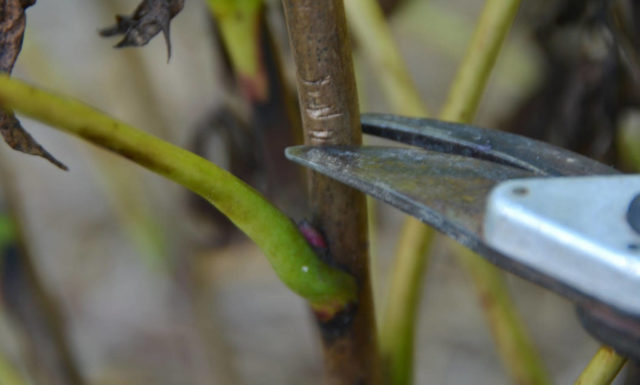
Pruning for the winter - high-quality prevention of many diseases
Compost mixed with wood ash can be added to improve soil nutrition. Dry grass is also used to nourish Lorelei peonies, as it retains moisture.
Mature shrubs do not need shelter. They tolerate low temperatures well. However, you should make sure that the plant is well protected from the wind, as it can be detrimental to the flower.
Pests and diseases
Numerous reviews of the Lorelei peony indicate that such a flower is resistant to infections and fungi. The only disease that often occurs among selectively bred peonies is gray rot. It usually develops in May and is accompanied by rotting stems, less often buds and leaves. A gray mold appears on the surface.
Main reasons:
- excess nitrogen in the soil;
- lack of nutrients;
- stagnation of fluid in the roots;
- the presence of other infected plants nearby;
- high humidity weather.
If gray rot appears on a peony, damaged shoots should be removed. For prevention, each bush is sprayed with copper sulfate (50 g per 10 liters of water). The peony itself and the soil around it are cultivated.
Among the pests of peonies are common:
- bronze beetle;
- nematodes;
- turf ants.
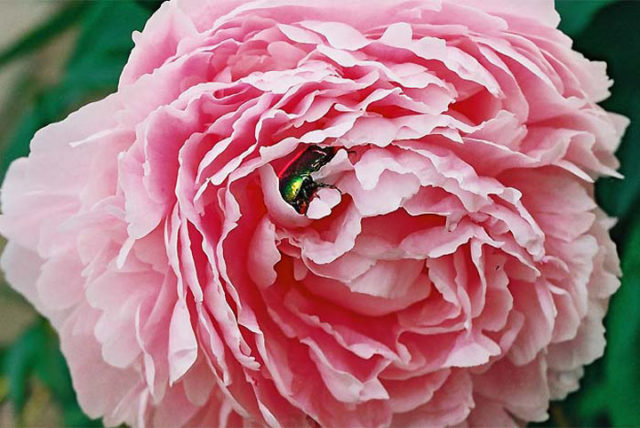
Treat the plant with fungicides and insecticides
Beetles can be picked by hand. Ants and nematodes require radical control methods. The soil, the site of the alleged location of insect nests, is treated with pesticides. The drugs Kinmix and Aktara are effective against nematodes. They have a detrimental effect on the worms, but they do not harm the root system of the peony.
Conclusion
Peony Lorelei is a rare variety with unique decorative properties. This plant is selectively bred, due to which it is resistant to unfavorable climatic factors, pests and diseases. The flower is unpretentious to care for, so it can be grown by novice and experienced gardeners.
Reviews about peony Lorelei
